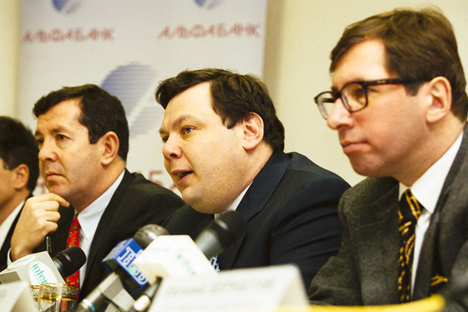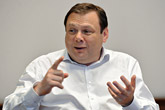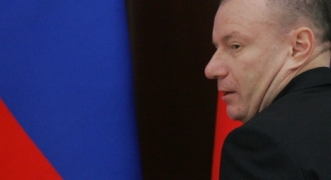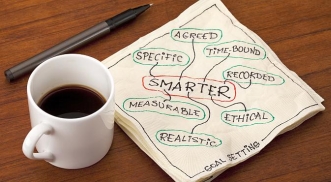A Russian American invests in Europe

The Alfa-bank trio. From left to right: Alex Knaster, Mikhail Fridman, Petr Aven. Source: PhotoXpress
In Alex Knaster’s London office in Park Lane there’s a letter he bought at a Christie’s auction in 2007 for $157,326: a letter Ernest Hemmingway sent to his friend poet Ezra Pound in 1925 upon arrival to Spanish Pamplona. After that Hemingway embarked on The Sun Also Rises which celebrated the ancient town.
For more than 800 years on July 6, at midday sharp, the famous running of the bulls has been opening the San-Fermin fiesta where people risk their lives running along the streets with a herd of furious bulls raced to the corrida venue.
Knaster first attended Pamplona’s San-Fermin festival right after graduating from Harvard Business School in 1985 and has been back some 6-7 times since then.
He registered the Pamplona trade mark 20 years ago and in 2004 gave this name to his asset management company. One of the Alfa-group structures owned by Mikhail Fridman, German Khan and Alexey Kuzmichev was among the first shareholders with its funds aimed at investment in Europe and the US.
Since then, according to a Fridman contact, the company entrusted to Knaster about $2 billion. When reporting on Pamplona’s deals, foreign media refer to it as a company of “Russian oligarchs” from Alfa-group.
It is a big investor but by far not the only one, says Knaster, and nothing else links Pamplona to Russia. Pamplona manages $6.5 billion worth of assets. “American pension funds, large international financial institutions and funds of funds are among our investors,” he adds.
A Russian American
Alex Knaster was born in Moscow in 1959. At the age of 16 he left Russia for the US with his parents and got citizenship there. The family wasn’t particularly well-to-do, but he managed to win a scholarship from Carnegie Mellon University.
After graduating with a bachelor’s in electric engineering and mathematics he joined Schlumberger in 1980 as an engineer to work at the oil platforms in the Gulf of Mexico. This allowed him to earn enough money to pay for his degree at Harvard Business School, after which he worked at a few investment banks.
In 1995 Knaster returned to Russia as head of the Russian branch of Credit Suisse First Boston. “I came to Russia for an interesting job which turned into 6 years,” Knaster recalls. In 1998, just a couple of weeks before the August crisis, he resigned from Credit Suisse First Boston to accept Fridman’s offer of a CEO position at Alfa-bank.
Alexander Gafin, Alfa-bank former vice president, recalls that “Fridman entrusted to Knaster all the tough talks and deals that Alfa handled.”
On accepting the offer to join Alfa-bank, the investment banker got the bank’s stock purchase option which he took advantage of later.
“But I didn’t plan to stay in Russia forever: my own immediate family as well as my wife’s live in the US,” Knaster explains. Since Knaster had long cherished the idea of starting up his own business, it was decided that he would set up an asset management company where Alfa would invest some of its profit, says a Fridman contact.
According to him, one of Alfa structures invests in Pamplona. Therefore, the invested funds belong to Fridman, Khan and Kuzmichev pro rata to their shares in the Alfa-Group core structure -- CTF Holdings. According to Forbes, these are 46.85 percent, 29.88 percent and 23.27 percent respectively.
Thanks to Alfa, Pamplona raised €500 million in 2005 for its first private equity fund and the fund of funds (which invests in other funds’ assets).
Investing in Europe
Pamplona has several business directions with private equity funds at the core, which, Knaster says, account for over half of the managed assets (according to the company, $6.5 billion).
“Usually private equity funds commit themselves to certain limitations by investing only into certain regions or industries. They take decisions on whether to buy into public companies’ shares, buy bonds of companies on the brink of default to convert them through bankruptcy into joint stock capital, or to jointly buy shares.
This approach allows for more success in a certain area but it lacks in flexibility,” Knaster explains. “That’s why we decided from the outset to build no artificial constraints for our deals.”
There are no geographical limits either: 70 people of different nationalities work for Pamplona in its three offices in London, New York and Malta. “We consider about 300 deals annually, we follow up on 20 out of these and do spend some funds, while usually one or two eventually are signed off on,” says Knaster.
Pamplona, according to Knaster, buys assets which can be improved with financial instruments: “We do not usually meddle with production issues.”
For example, Pamplona has invested in Haanpaa, a Scandinavian company dealing with the transportation of liquid chemicals; Pegas, a Czech manufacturer of fiber for hygienic produce; SAF, a German producer of truck components and Amor, a German jewelry chain.
In crisis Pamplona closed one of its most successful deals by buying TMD Friction, one of the world’s biggest producers of automobile brake systems and Germany’s oldest, for 639 million. In 2008 due to the decline in orders from automobile producers the company was penniless and could not service its debts.
It ended up declaring a controlled bankruptcy by the end of the year. The parties did not disclose the sum of the transaction; according to the unquote.com analytical resource, it cost Pamplona about €100 million ($130 million).
Related:
Business and hi-tech - Young entrepreneurs pursue Forbes' billionaires
“Knaster foresaw that in crisis people won’t buy new cars but would rather stick with the old ones replacing wearing off brake shoes with new ones, so the demand for these will be on the rise around the world,” Gafin praises his former colleague.
TMD expanded the chain of components for sale on the secondary market and launched new brands in this industry. The components market started growing and the new cars market started recovering later on.
In 2010 the company’s revenue reached €638 million ($829 million) – 20 percent more than in 2009, EBITDA totaled €71 million ($92 million) with 160 percent of growth. TMD reported then that its sales increase in 2010 was due, in the first place, to the components secondary market, which accounted for 70 percent of its sales.
Three funds
Today Pamplona has grown to comprise three funds. Pamplona Capital Partners II, the second private equity fund worth €1.3 billion ($1.7 billion) was formed in 2007 (Alfa’s share is not known). The transaction volume of its own funds grew from €40 million ($52 million) to €200 million ($260 million).
Pamplona Capital Partners III, the third private equity fund worth €2 billion ($2.6 billion) was formed in 2012 and has not yet raised a full investment pool (Alfa’s share is not known).
Its limit of its own capital investment is even bigger – between €100 and €400 million ($130 and $520 million), which could be employed, helped by credit, to acquire control stakes in big companies.
According to Knaster, Pamplona Capital Partners I profitability totals 200 percent, i.e. about €644 million ($836 million). Pamplona Capital Partners II is expected to harvest 100 percent or €1.3 billion ($1.7 billion).
“I think both Pamplona funds display very good results,” says Nicolas Jordan, co-head of Goldman Sachs operations in Moscow. According to him, recently, a good return on capital has been around 9-12 percent annually, 15-20 percent annually is a very good result while 20-30 percent is rarely achievable.
First published in Russian in Vedomosti
All rights reserved by Rossiyskaya Gazeta.
Subscribe
to our newsletter!
Get the week's best stories straight to your inbox



